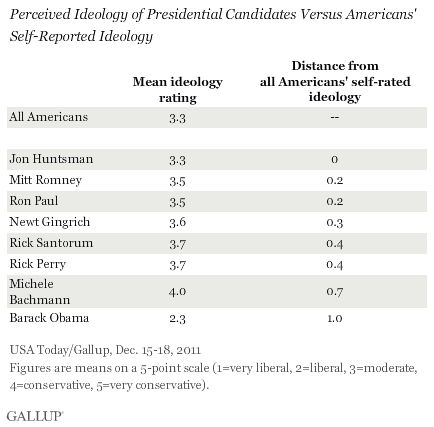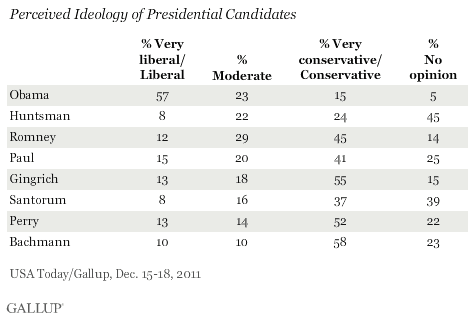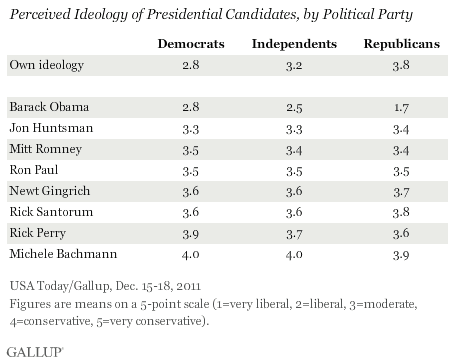PRINCETON, NJ -- Americans perceive Jon Huntsman, Mitt Romney, and Ron Paul as closest to themselves ideologically, and Michele Bachmann and Barack Obama as furthest away.
A USA Today/Gallup poll asked Americans to rate their own ideology -- and the ideology of the eight major presidential candidates -- on a 5-point scale with 1 being very liberal and 5 being very conservative. Americans' mean score on this scale is 3.3, meaning the average American is slightly to the right of center ideologically. Huntsman's score matches that at 3.3, but that mean rating excludes the 45% of Americans who did not have an opinion of Huntsman. Of the better known candidates, Romney's and Paul's 3.5 scores are closest to the average American's ideology.

Overall, 42% of Americans in the Dec. 15-18 poll describe themselves as very conservative or conservative, 19% as very liberal or liberal, and 37% as moderate. Those figures are in line with what Gallup has measured in recent years for ideological self-identification.
A majority of Americans, 57%, perceive Obama to be liberal, with 23% describing his views as moderate and 15% as conservative.
Many Americans are not highly familiar with the Republican candidates, with between 14% and 45% of respondents unable to rate the GOP candidates' ideologies. However, for the most part, Americans are twice as likely to view the Republican candidates as conservative than as moderate. Two exceptions to this are Romney, whom 45% of Americans view as conservative and 29% moderate, and Huntsman, who is nearly as likely to be perceived as moderate (22%) as conservative (24%).

Republicans' Ratings Push Obama to the Extremes
Obama's mean ideology rating ends up furthest away from Americans' own mean score because Republicans place him far to the left, with an average of 1.7, compared with 2.5 among independents and 2.8 among Democrats. In fact, Obama is the only candidate whose ideology is perceived very differently by party groups; Republicans, Democrats, and independents generally perceive each of the Republican candidates' views similarly.

Obama's average 2.8 ideology rating among Democrats matches the average Democrats give themselves, suggesting he is right in line ideologically with his party's supporters.
Among Republicans, Rick Santorum's 3.8 equals the party rank-and-file's average ideology, with all other GOP candidates, except Bachmann, to the left of that average. Notably, Huntsman and Romney are furthest away from Republicans' own ideological placement, though not by a very large margin.
Huntsman (3.3) and Romney (3.4) are the closest of all the candidates to independents' self-rated ideology (3.2).
Implications
If Americans chose their president solely on the basis of the fit between their own ideological views and their perceptions of the candidates' views, Huntsman, Romney, and Paul would be in the best position for the 2012 election. While a close ideological fit is clearly a political asset, many other factors go into selecting a president, including evaluations of national conditions, such as the economy, the performance of the president and his party, and the platform each candidate is running on.
Indeed, Obama's mean ideology rating four years ago was 2.5, essentially the same as now, and he was perceived to be slightly more liberal (with a score of 2.2) immediately before the election. Americans' own ideology ratings in December 2007 (3.2) and October 2008 (3.3) were essentially the same as now, and closer to John McCain's (3.4 in December 2007 and 3.7 in October 2008) than Obama's.
Also, the data make clear that Americans are not highly familiar with the views of the leading Republican candidates at this point -- at least one in seven cannot rate even the best known candidate (Romney), and at this point there is little differentiation in the views of the Republican candidates by party.
As the candidates continue to campaign and a GOP nominee emerges, Americans will learn more about the candidate and may perceive him or her differently than they do today.
Survey Methods
Results for this USA Today/Gallup poll are based on telephone interviews conducted Dec. 15-18, 2011, with a random sample of 1,019 adults, aged 18 and older, living in all 50 U.S. states and the District of Columbia.
For results based on the total sample of national adults, one can say with 95% confidence that the maximum margin of sampling error is ±4 percentage points.
For results based on the total sample of 284 Democrats, one can say with 95% confidence that the maximum margin of sampling error is ±7 percentage points.
For results based on the total sample of 303 Republicans, one can say with 95% confidence that the maximum margin of sampling error is ±7 percentage points.
For results based on the total sample of 406 independents, one can say with 95% confidence that the maximum margin of sampling error is ±6 percentage points.
Interviews are conducted with respondents on landline telephones and cellular phones, with interviews conducted in Spanish for respondents who are primarily Spanish-speaking. Each sample includes a minimum quota of 400 cell phone respondents and 600 landline respondents per 1,000 national adults, with additional minimum quotas among landline respondents for gender within region. Landline telephone numbers are chosen at random among listed telephone numbers. Cell phones numbers are selected using random digit dial methods. Landline respondents are chosen at random within each household on the basis of which member had the most recent birthday.
Samples are weighted by gender, age, race, Hispanic ethnicity, education, region, adults in the household, and phone status (cell phone-only/landline only/both, cell phone mostly, and having an unlisted landline number). Demographic weighting targets are based on the March 2010 Current Population Survey figures for the aged 18 and older non-institutionalized population living in U.S. telephone households. All reported margins of sampling error include the computed design effects for weighting and sample design.
In addition to sampling error, question wording and practical difficulties in conducting surveys can introduce error or bias into the findings of public opinion polls.
View methodology, full question results, and trend data.
For more details on Gallup's polling methodology, visit https://www.gallup.com/.
